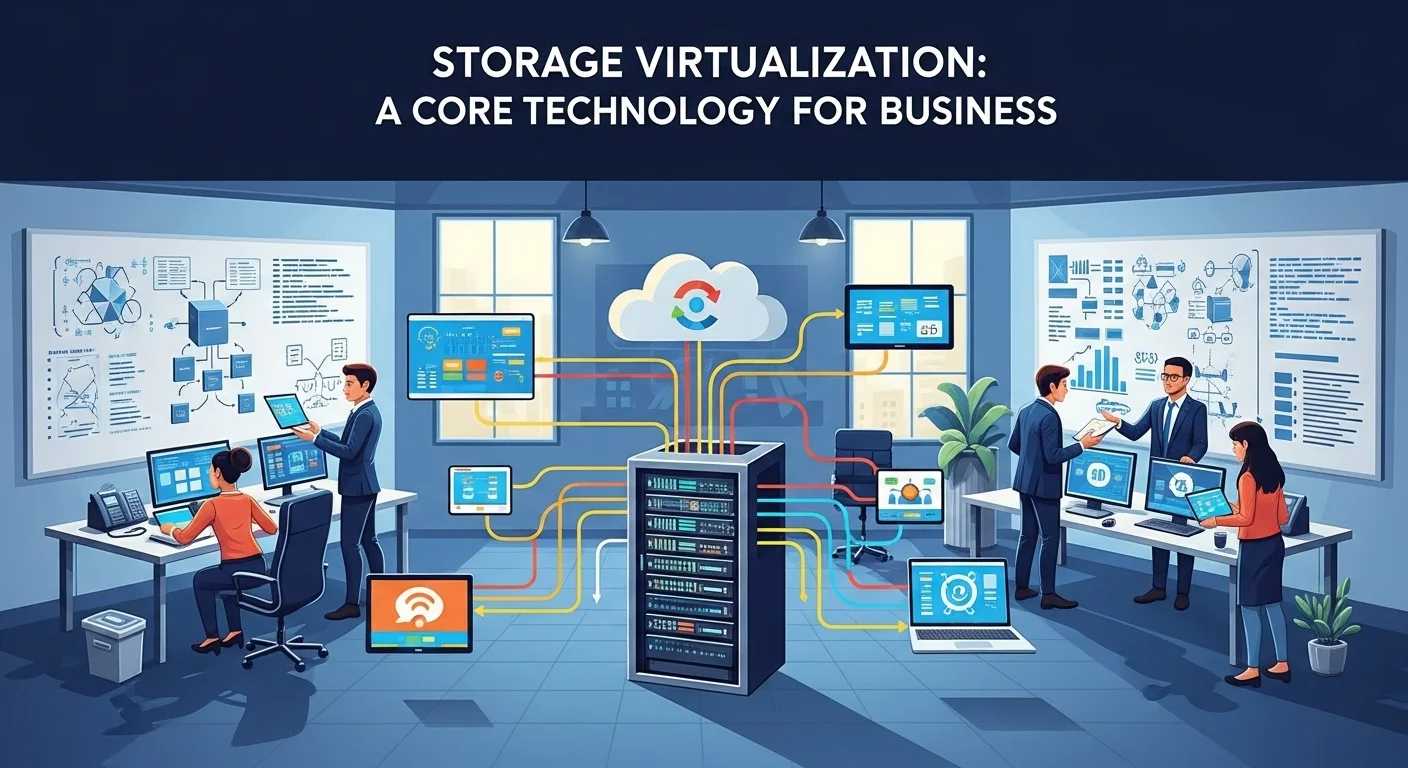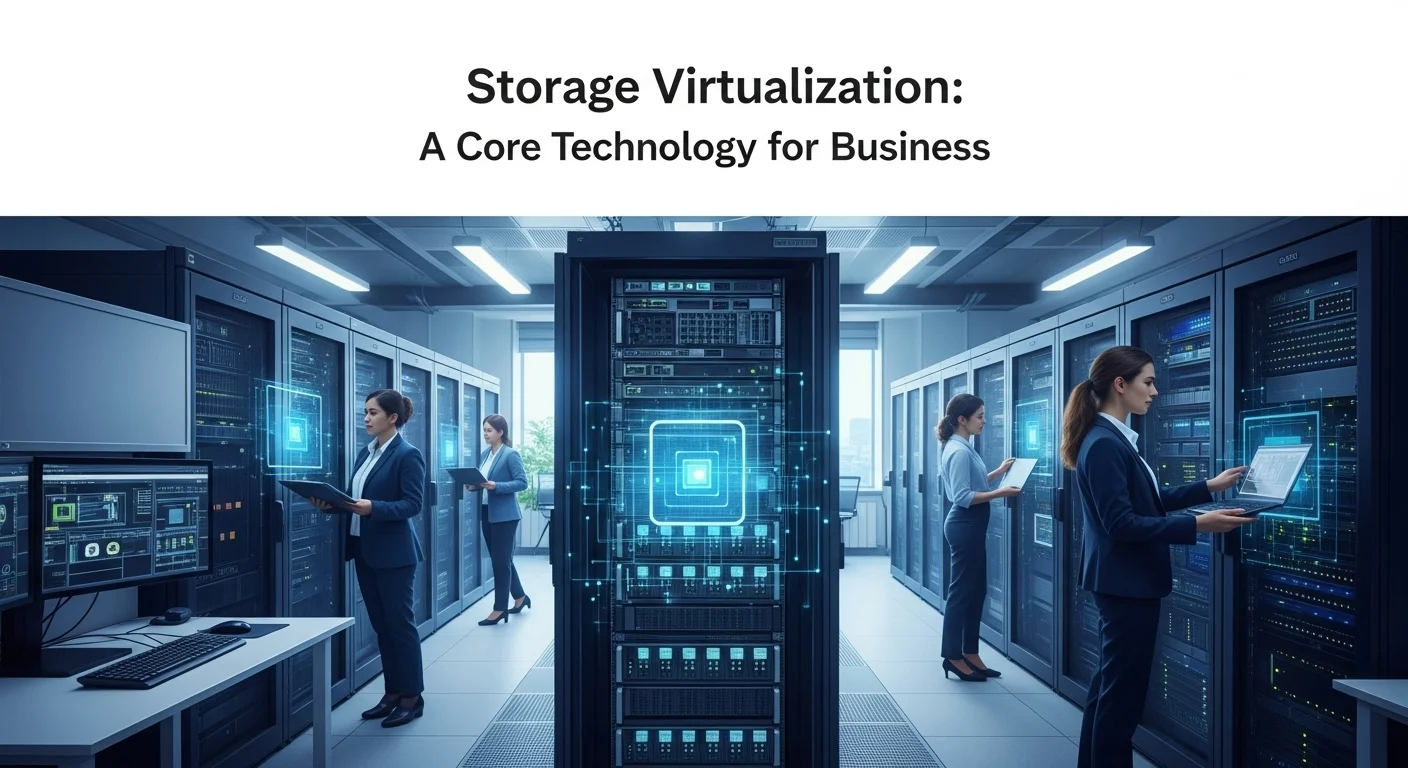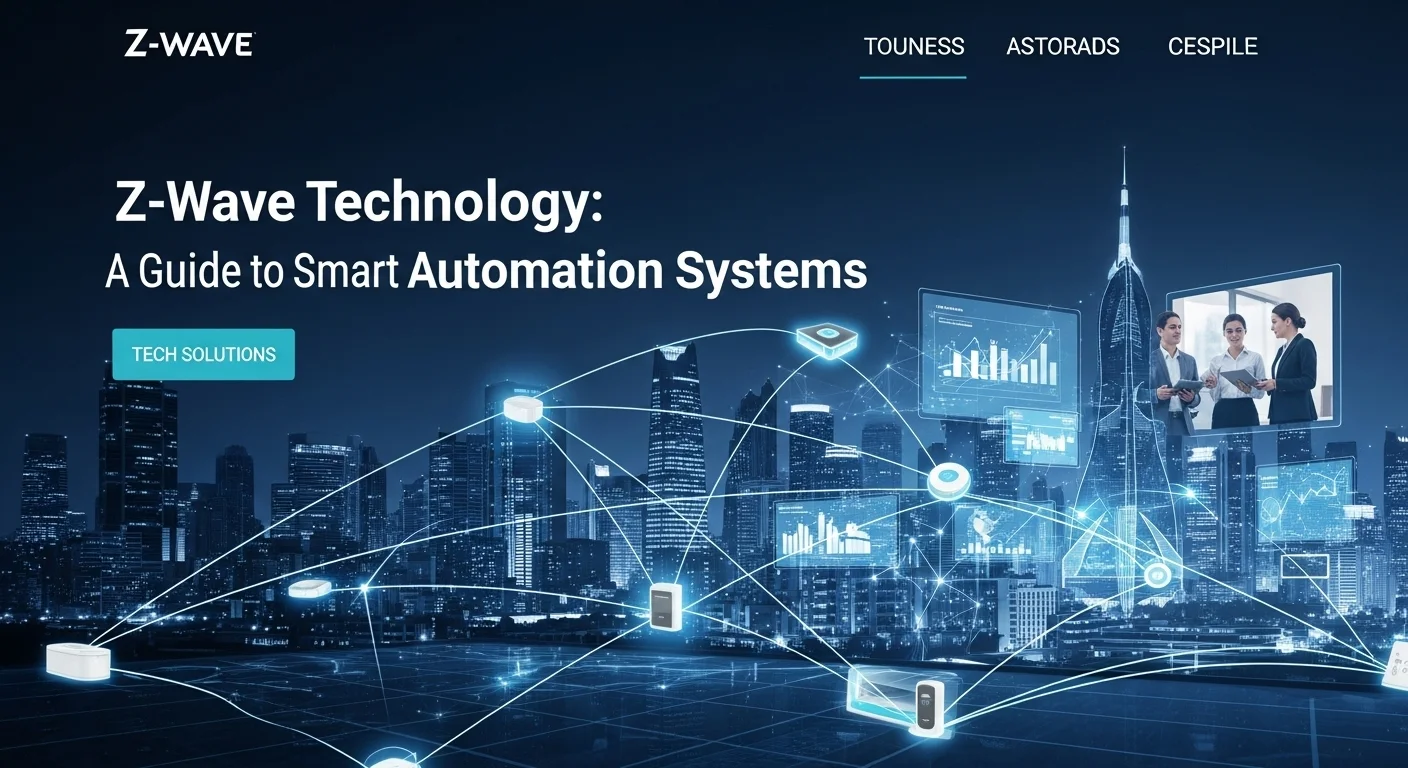Storage Virtualization: A Core Technology for Business

Executive Summary
Storage Virtualization is a transformative technology that pools physical storage from multiple devices into a single, centrally managed resource. This abstraction of hardware simplifies complex storage environments, leading to significant improvements in efficiency, flexibility, and scalability. For businesses and technology enthusiasts, understanding storage virtualization is crucial as it forms the backbone of modern data centers and cloud computing services. By creating a unified pool of storage, organizations can optimize resource utilization, streamline data management tasks like backups and recovery, and reduce both capital and operational expenditures. This technology enables seamless data migration, enhances disaster recovery strategies, and provides the agility required to adapt to ever-changing data demands. As we delve deeper, we will explore how this technology is not just a technical concept but a strategic business enabler, powering everything from enterprise data solutions to the vast, on-demand resources offered by cloud providers. This article serves as a comprehensive guide to its concepts, benefits, types, and real-world applications in today's tech-driven landscape.
Table of Contents
What is Storage Virtualization and why is it important in Technology?
In the ever-evolving landscape of information technology, the term 'virtualization' has become ubiquitous, fundamentally changing how we deploy servers, networks, and, most critically, storage. Storage virtualization is the process of pooling physical storage from multiple, disparate storage devices into what appears to be a single, logical storage device. [1] This technology creates an abstraction layer that separates the logical view of storage from the physical implementation, effectively hiding the complexity of the underlying storage area network (SAN) or network-attached storage (NAS) systems. [1] Imagine a library where instead of knowing the exact shelf and position of every book, you simply request a book from a librarian who retrieves it for you from a vast, consolidated collection. The virtualization software acts as this intelligent librarian, managing and presenting a unified catalog of storage resources to applications and servers. [5] This centralized management console simplifies administration, allowing IT professionals to allocate, manage, and protect data with unprecedented ease and efficiency. [1] The importance of this technology in the modern IT ecosystem cannot be overstated. It addresses several core challenges that have plagued data management for decades: data silos, hardware dependency, and underutilization of resources. By breaking down the barriers between different storage systems—from different vendors, of different ages, and with different capabilities—storage virtualization creates a homogenous, flexible, and highly efficient storage environment. [6]
The Technological Imperative for Storage Virtualization
From a technological standpoint, storage virtualization is a cornerstone of the software-defined data center (SDDC). It enables a shift from a hardware-centric to a software-centric approach to IT infrastructure. This paradigm shift offers numerous advantages. Firstly, it provides hardware independence. Organizations are no longer locked into a single storage vendor. Virtualization platforms can pool resources from various systems, allowing businesses to choose the best hardware for their needs and budget without worrying about compatibility issues. [6] This extends the life of older storage systems, which can be integrated into the virtual pool and repurposed for less critical tasks like archiving, maximizing return on investment. [19] Secondly, it drastically improves resource utilization. Traditional storage provisioning often leads to 'stranded capacity'—unused disk space on various arrays that cannot be easily allocated elsewhere. Storage virtualization aggregates all this unused space into a single pool, ensuring that capacity is used to its fullest potential. [2] Features like thin provisioning, which allocates space on a just-in-time basis, further enhance this efficiency. Thirdly, it simplifies and accelerates data management tasks. Operations like data migration, which used to be complex, risky, and disruptive projects, become seamless background processes in a virtualized environment. [2] An administrator can move data from an old array to a new one, or between different tiers of storage (e.g., from high-performance SSD to low-cost HDD), without any downtime for the applications using that data. This agility is critical for maintenance, upgrades, and load balancing. Furthermore, advanced data services such as snapshots, clones, and replication can be applied uniformly across the entire storage pool, regardless of the underlying hardware's capabilities. [4] This standardizes data protection and disaster recovery strategies, making the entire infrastructure more resilient.
The Crucial Role of Storage Virtualization in Cloud Computing
The rise of cloud computing is inextricably linked to the power of virtualization. Indeed, storage virtualization in cloud computing is the fundamental technology that allows service providers like Amazon Web Services (AWS), Microsoft Azure, and Google Cloud Platform (GCP) to offer vast, scalable, and elastic storage services. [12] When a user provisions storage in the cloud, they are not interacting with a specific physical disk drive. Instead, they are interacting with a logical representation of storage carved out from a massive, multi-tenant pool of virtualized resources. [14] This is the essence of how utility cloud computing services offer virtual storage. They abstract the immense complexity of their global data centers, presenting customers with simple, on-demand storage options such as block storage (Amazon EBS), object storage (Amazon S3), or file storage (Amazon EFS). [35] The concept of data storage virtualization in cloud computing is what makes this possible. It ensures that a user's data is logically isolated and secure, even though it may physically reside on the same hardware as data from other tenants. [5] The virtualization layer manages the mapping, access control, and performance to meet the service level agreements (SLAs) for each customer. This model is often tightly integrated with compute resources. It is common that utility cloud computing services offer virtual storage and server resources as a bundled package. [14] For instance, a virtual machine (an EC2 instance in AWS) is launched with an attached virtual block storage volume (an EBS volume). This tight coupling of virtualized compute and storage creates a highly flexible and scalable environment where applications can be deployed and scaled in minutes, a feat impossible with traditional physical infrastructure. The different types of storage virtualization in cloud computing mirror the traditional models but are delivered as a service. Block storage as a service provides raw volumes for databases and applications, file storage as a service offers shared file systems, and object storage as a service provides a highly durable and scalable platform for unstructured data like backups, archives, and media content. This service-oriented delivery, powered by virtualization, has democratized access to enterprise-grade storage capabilities, allowing businesses of all sizes to leverage powerful infrastructure without the upfront capital investment. [8]
Business Applications and Strategic Benefits
The strategic benefits of storage virtualization extend far beyond the IT department, impacting the entire business. The primary driver for adoption is often cost savings. By improving storage utilization and reducing the need for new hardware purchases, virtualization lowers capital expenditures (CapEx). [8] Simultaneously, by simplifying administration and automating routine tasks, it reduces the operational expenditures (OpEx) associated with managing a complex storage environment. [8] This financial efficiency allows organizations to redirect resources toward innovation and other value-adding activities. Business agility is another significant benefit. In a competitive market, the ability to respond quickly to new opportunities is paramount. Storage virtualization provides the flexibility to provision new application environments, scale existing ones, or set up development and testing sandboxes in a fraction of the time it would take with physical hardware. [16] This accelerates time-to-market for new products and services. Enhanced business continuity and disaster recovery (BCDR) is perhaps one of the most critical advantages. Virtualization simplifies the process of replicating data to a secondary site. [3] Because the virtualization layer abstracts the hardware, the disaster recovery site does not need to have identical storage hardware to the primary site, which can significantly reduce costs. The ability to perform automated failover and failback between sites ensures that the business can continue to operate even in the face of a major outage, minimizing downtime and potential revenue loss. In summary, storage virtualization is not merely a technical tool for consolidation; it is a strategic technology that provides a foundation for a more agile, resilient, and cost-effective IT infrastructure. It is the invisible engine that powers the modern data center and the cloud, enabling businesses to manage the explosive growth of data and harness its value effectively. Understanding the various types of storage virtualization in cloud computing and how utility cloud computing services offer virtual storage and server solutions is essential for any modern technology professional or business leader looking to leverage technology for competitive advantage.

Complete guide to Storage Virtualization in Technology and Business Solutions
Diving deeper into the world of storage virtualization reveals a sophisticated ecosystem of technologies, architectures, and strategies. Understanding these technical underpinnings is essential for implementing a solution that is robust, scalable, and aligned with business objectives. This guide provides a comprehensive look at the methods, techniques, and comparisons necessary to make informed decisions about storage virtualization, with a particular focus on its application in modern IT and cloud environments.
Technical Methods: How Storage Virtualization Works
At its core, storage virtualization operates through a virtualization layer or engine. This software or firmware component sits between the hosts (servers) and the physical storage devices. [5] Its primary function is to intercept all input/output (I/O) requests from the hosts and intelligently redirect them to the appropriate physical location on the storage arrays. [1] This process involves three key activities: pooling, abstraction, and mapping. Pooling: The first step is to aggregate the physical storage capacity from multiple, often heterogeneous, storage systems into a single, unified pool of resources. [6] This breaks down the physical barriers between different SAN or NAS devices. Abstraction: The virtualization engine then presents this pooled capacity to the host servers as logical volumes or file shares. These logical units, often called Logical Unit Numbers (LUNs) in a block environment, appear to the server's operating system as standard physical disks, even though they are virtual constructs. [2] The server is completely unaware of the underlying complexity, such as which specific array, RAID group, or physical disk is actually servicing its requests. Mapping: The engine maintains a complex set of metadata maps that track the relationship between the logical blocks of data presented to the host and the physical blocks of data on the storage devices. [2] When a host writes data to a logical volume, the virtualization engine consults its map, determines the best physical location for that data based on policies (e.g., performance tier, data protection level), and writes the data accordingly. This dynamic mapping is what enables advanced features like non-disruptive data migration and automated storage tiering.
Architectural Approaches: Host, Array, and Network-Based
There are three primary architectural models for implementing storage virtualization, each with its own set of advantages and disadvantages. The choice of architecture depends on factors like existing infrastructure, performance requirements, and budget. These models are also relevant when considering the different types of storage virtualization in cloud computing, as cloud providers often use a combination of these approaches to build their services.
1. Host-Based Virtualization
In this model, the virtualization software runs directly on the host servers. [3] This can be in the form of a special volume manager, a device driver, or integrated into the hypervisor itself (in the case of server virtualization). Products like VMware's Virtual Machine File System (VMFS) and software-defined storage (SDS) solutions like VMware vSAN are prime examples. [5] Pros: It is often the lowest-cost option, as it leverages the server's existing CPU and memory resources without requiring dedicated hardware. It is also highly scalable in a scale-out fashion, where adding more hosts increases both compute and storage capacity (as seen in hyper-converged infrastructure, or HCI). Cons: It consumes resources on the host, which could otherwise be used by applications. Management can become decentralized, as each host or cluster of hosts might have its own virtualization instance. It can also create compatibility issues if the environment consists of multiple operating systems or hypervisors.
2. Array-Based Virtualization
Here, the virtualization capability is built into the firmware of a primary storage array or controller. [2] This 'master' array takes control of other, often older or less capable, storage arrays, pooling their capacity and managing it alongside its own internal storage. Dell EMC PowerFlex and IBM Spectrum Virtualize (the software powering the SAN Volume Controller) can operate in this mode. Pros: This approach can deliver very high performance, as the virtualization functions are handled by specialized hardware (ASICs) within the storage controller. It provides a centralized point of management for all attached arrays. Cons: The most significant drawback is the potential for vendor lock-in. [2] You are typically tied to the capabilities and compatibility list of the primary array's vendor. It also represents a potential single point of failure and a performance bottleneck if the primary controller is not powerful enough to handle the I/O from all the attached arrays.
3. Network-Based Virtualization
This is the most common and flexible approach in enterprise environments. [3] It involves placing a dedicated virtualization appliance or 'smart' switch in the network path, typically on the SAN, between the hosts and the storage arrays. [1] This appliance, like an IBM SAN Volume Controller (SVC) or a DataCore SANsymphony node, intercepts all storage traffic and performs the virtualization functions. Pros: Its greatest strength is heterogeneity. It is completely independent of the host servers and the storage arrays, allowing it to virtualize storage from virtually any vendor. This provides maximum flexibility and eliminates vendor lock-in. It offers a single, centralized point of management for the entire storage infrastructure. Cons: It can introduce an additional point of failure into the data path (though this is always mitigated with redundant, clustered appliances). It can also add a small amount of latency to I/O operations, and the initial cost of the appliance can be significant.
Business Solutions and the Cloud Connection
These virtualization architectures are the building blocks for powerful business solutions. For instance, the concept of data storage virtualization in cloud computing is often implemented using a large-scale, highly customized version of network-based or host-based virtualization. When a cloud customer requests a new virtual disk, the cloud provider's orchestration platform communicates with a massive virtualization layer that carves out a logical volume from a vast pool of physical resources. [7] This is precisely how utility cloud computing services offer virtual storage on a pay-as-you-go basis. The elasticity and scalability of the cloud are direct results of this underlying virtualization. [12] Furthermore, the integration of compute and storage is a key business enabler. The fact that utility cloud computing services offer virtual storage and server resources together allows businesses to deploy entire application stacks with just a few clicks. [14] This synergy is mirrored in on-premises solutions like Hyper-Converged Infrastructure (HCI), which uses host-based storage virtualization to combine compute, storage, and networking into a single, easy-to-manage appliance. This simplifies data center operations and lowers the total cost of ownership. Comparing these solutions involves evaluating trade-offs. An on-premises, network-based virtualization solution offers maximum control and performance but requires significant capital investment and management overhead. Conversely, leveraging storage virtualization in cloud computing offers unparalleled flexibility, scalability, and zero hardware management, but may involve trade-offs in terms of performance predictability and data sovereignty. A hybrid cloud strategy, which combines both, often provides the best of both worlds, using on-premises virtualized storage for performance-sensitive workloads and the cloud for disaster recovery, archiving, and bursting capacity. Understanding the technical methods and architectural options is crucial for any organization looking to implement or consume storage virtualization. Whether building a private cloud, deploying an HCI solution, or consuming services from a public cloud provider, the principles remain the same: abstracting the physical to deliver logical, flexible, and efficient storage services.

Tips and strategies for Storage Virtualization to improve your Technology experience
Successfully implementing and managing a storage virtualization solution requires more than just understanding the technology; it demands careful planning, adherence to best practices, and a forward-looking strategy. Whether you are deploying on-premises or leveraging the cloud, these tips and strategies will help you maximize the benefits of storage virtualization, enhance your technology experience, and drive business value. From initial assessment to ongoing optimization and security, a holistic approach is key to harnessing the full power of this transformative technology.
Best Practices for Implementation and Management
A successful storage virtualization journey begins long before the first piece of hardware or software is deployed. It starts with a comprehensive strategy.
1. Thorough Assessment and Planning
Before you begin, assess your current environment. [18] Use monitoring tools to gather metrics on capacity utilization, performance (IOPS, throughput, latency), and workload characteristics. [18] Identify which applications are business-critical and have stringent performance or availability requirements. This data-driven approach will inform your design, helping you to size your virtualization solution correctly and choose the right storage tiers. Don't just plan for today; forecast your future growth to ensure the solution you choose can scale with your business needs. [15]
2. Choose the Right Architecture and Vendor
Based on your assessment, select the architecture—host, array, or network-based—that best fits your needs. [3] For highly virtualized server environments, a host-based solution like HCI might be ideal. For large, heterogeneous environments, a network-based appliance often provides the most flexibility. [14] When selecting a vendor, look beyond the feature list. Consider the vendor's support reputation, their ecosystem of partners, and their long-term roadmap. Avoid getting locked into a proprietary solution that will limit your future options. [2]
3. Phased Migration and Data Placement
Don't attempt a 'big bang' migration. Start with less critical applications to gain experience and build confidence in the new platform. Develop a detailed migration plan that minimizes disruption. [15] Once the platform is live, establish clear data placement policies. Use automated storage tiering to ensure that your most active, performance-sensitive data resides on your fastest storage (e.g., NVMe SSDs), while less frequently accessed data is automatically moved to more cost-effective tiers (e.g., SATA HDDs). [6] This optimizes both performance and cost.
4. Proactive Monitoring and Optimization
Implementation is not the end of the project. Continuously monitor the health and performance of your virtualized storage environment. [11] Track key metrics and set up alerts to be notified of potential issues before they impact users. Regularly review performance reports to identify bottlenecks, such as an overloaded storage controller or a saturated network link. [17] Use the insights gained from monitoring to optimize your resource allocation, adjust tiering policies, and plan for future capacity upgrades. [11]
Leveraging Storage Virtualization in a Cloud Context
The principles of storage virtualization are foundational to cloud computing, and understanding how to leverage them is critical for any modern business. The concept of storage virtualization in cloud computing allows for immense operational efficiencies. [7] For instance, when you use a service like AWS or Azure, you are benefiting from their massive investment in data storage virtualization in cloud computing. To make the most of this, it's essential to understand the different service tiers they offer. A key strategy is to match your workload requirements to the correct cloud storage service. For a high-transaction database, you would use a provisioned IOPS block storage service. For backups and archives, a low-cost object storage tier would be more appropriate. This is a practical application of understanding the different types of storage virtualization in cloud computing. Many businesses adopt a hybrid cloud model. Here, you might use an on-premises storage virtualization platform for your primary workloads and replicate data to the cloud for disaster recovery. This strategy leverages the fact that utility cloud computing services offer virtual storage that is ideal for a DR target—it's cost-effective, scalable, and geographically distant. Furthermore, the tight integration where utility cloud computing services offer virtual storage and server instances together simplifies the creation of a full-fledged DR site that can be spun up on demand.
Security and Future-Proofing Your Strategy
Security is paramount in any storage system, and virtualized environments are no exception. Implement a multi-layered security strategy. Use data encryption for both data-at-rest (on the physical disks) and data-in-transit (as it moves across the network). Enforce strong access controls using role-based access control (RBAC) to ensure that administrators and users only have access to the resources they need. Regularly audit access logs to detect any suspicious activity. The world of technology is constantly changing. To future-proof your storage strategy, keep an eye on emerging trends. Software-Defined Storage (SDS) is the logical evolution of storage virtualization, offering greater automation and policy-based management. [6] Hyper-Converged Infrastructure (HCI) continues to gain traction for its simplicity and scalability. [3] New technologies like NVMe over Fabrics (NVMe-oF) promise to dramatically reduce storage network latency, while container-native storage solutions are becoming essential for managing persistent data in Kubernetes and other microservices environments. [4] By embracing a strategy of continuous learning and adaptation, you can ensure that your storage infrastructure remains a powerful asset that supports, rather than hinders, your business's innovation and growth. A well-executed storage virtualization strategy, grounded in best practices and forward-thinking, will provide the agility, efficiency, and resilience needed to thrive in the digital age. For more in-depth technical information and best practices, resources from leading technology analysis firms like Gartner or Forrester can provide valuable vendor comparisons and market insights.
Expert Reviews & Testimonials
Sarah Johnson, Business Owner ⭐⭐⭐
The information about Storage Virtualization is correct but I think they could add more practical examples for business owners like us.
Mike Chen, IT Consultant ⭐⭐⭐⭐
Useful article about Storage Virtualization. It helped me better understand the topic, although some concepts could be explained more simply.
Emma Davis, Tech Expert ⭐⭐⭐⭐⭐
Excellent article! Very comprehensive on Storage Virtualization. It helped me a lot for my specialization and I understood everything perfectly.



